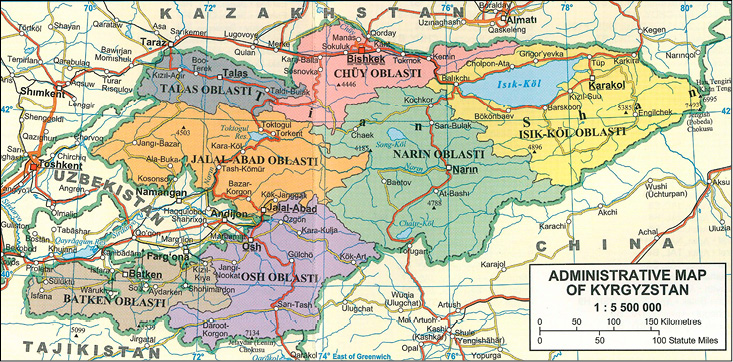- 1. Twin-bar tunes (ex.1-11, №1-58)
- Twin-bar tunes based on the g,-c bichord
- Twin-bar tunes based on rotating motifs
- Twin-bar tunes with descending/hill-shaped lines
- Motifs with a downward leap at the end of the line
- Motivic processes
- 2. Tunes moving on Ionian scales (ex.12-24, №59-164))
- Laments and their relatives
- Two-lined tunes of Major character with higher main cadences and their four-lined relatives
- Four-lined tunes of Major character
- 3. Aeolian tunes (ex.25-36, №165-238)
- Laments and related tunes
- Aeolian tunes with higher main cadence
- Four-lined tunes of Minor character
- Valley-shaped, ascending or undulating first line
- 4. Caramazan religious tunes (ex.37-41, №239-326)
- 5. Tunes of domed structure (ex.42-43, №327-332)
Kyrgyz expeditions, Kyrgyzstan,
the Kyrgyz people
the Kyrgyz people
The former Soviet republic of Kirghizia (from 1997 Kyrgyz Republic) is situated in the heart of Central Asia, bordering Kazakhstan in the north, China in the southeast, Tajikistan in the southwest and Uzbekistan in the west (6.202.000). The chief cities are Bishkek, the capital, and Osh in the south.
Kyrgyzstan is a mountainous country in the Tien-Shan and Pamir systems, rising to 24,409 ft (7,440 m) at Pobeda Peak on the Chinese border. Ninety-four percent of the country is over 3,300 ft (1,000 m) above sea level, with an average elevation of 9,020 ft (2,750 m). Lake Issyk-kul lies in the northeast. The climate is extremely continental with great regional variations.
Kyrgyzstan was the first of the Central Asian republics to acquire democratic institutions. Governed under the constitution of 1993, it has a 105-member bicameral parliament. The president, elected by popular vote, is head of state. The country is divided into six administrative regions and the capital area.

Map 1 Administrative map of Kyrgyzstan
The Kyrgyz people speak a Kipchak Turkic language closely related to Kazakh. Along with the Kyrgyz language, Russian is de facto the language of communication.
Kyrgyzstan is a multi-ethnic state, and most of the population are Muslims. The Kyrgyz make up the biggest ethnic entity: half of the inhabitants are Kyrgyz. 21 per cent are Russians, their number was declining. Like Russian migrants from former Soviet republics, some didn’t find their place in Russia and keep returning, but no longer as privileged citizens of an empire. In addition to the Kyrgyz and the Russians, there are 13 per cent Uzbeks, 3 per cent Ukrainians and 2 per cent Germans in the republic. Other important ethnics are Tatars, Kazakhs, Dungans, Uighurs and Tajiks. About two thirds of the population is rural.
Traditionally the Kyrgyz were pastoral nomads. After the Russian conquest, however, they were gradually settled with seasonal migration to the pastures in the mountains. Since then most of the Kyrgyz were farmers in the countryside, but due to the economic problems during the last decades there is an accelerating mobility to the cities.
The nomadic Kyrgyz have organized their politics according to tribal rules and traditions. The most important organizational units have been the tribe, clan and the extended family. Despite the Soviets’ attempts to subdue the traditional forms of organization, tribalism, in some respects, was an implicit form of organization also during Soviet rule.
The clan or extended family is a patrilinear unit and the members of the clan descend from a common known ancestor. The clan members are connected to a village or an area, whether the members of the clan live there or not. The head of the extended family/clan is one of the elders (aksakal), and normally one of the aksakals is the head of the village. When difficult questions have to be solved, several aksakals discuss the questions in a village council. A tribe is a congregation of many clans and branches off into sub-tribes and sub-sub-tribes all the way down to the level of a clan. (Hvoslef 1997: 96-108)
During my fieldwork I asked my informants which tribe and clan they belonged to and always mark this information. Today’s Kyrgyz people divide into two tribal alliances: the otuz uul and the içkilik (inner). Parts of otuz uul are ong kanat and sol kanat (right and left wings). Some of their tribe and clan names occur among their neighbours, too (e.g. Qitay, Quşçu, Kipçak, Nayman, Qungrat). In the northern part of the country there are only a few large tribes. The most important ones are: Solto, Sayak, Sarıbağış and Buğu. In southern Kyrgyzstan there are many small tribes. A feature of interest: the Kyrgyz do not vote according to party programs, but rather according to the tribe or clan of the party leader.
In the last 90 years the region has undergone a rapid process of modernization. Factories, roads, railroads, airfields, modern dwellings and power stations were built. The educational system of the Soviet Union was also exported to the distant regions of Central Asia. The Kyrgyz State National University was established in 1951 and the Kyrgyzstan Academy of Sciences in 1954; by the late 1990s there were over 20 universities in the country.
Kyrgyzstan is probably the most democratic republic in Central Asia today. There is political pluralism and a free press.
Let us return from the present into the distant past and outline the main issues of the ethnogenesis of the Kyrgyz people.
